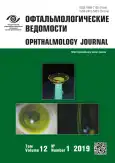Алгоритм объективного осмотра пациента с блефароптозом
- Авторы: Потемкин В.В.1,2, Гольцман Е.В.2
-
Учреждения:
- ФГБОУ ВО «Первый Санкт-Петербургский государственный медицинский университет им. академика И.П. Павлова» Минздрава России
- СПбГУЗ «Городская многопрофильная больница № 2»
- Выпуск: Том 12, № 1 (2019)
- Страницы: 45-51
- Раздел: Научные обзоры
- URL: https://journals.rcsi.science/ov/article/view/9323
- DOI: https://doi.org/10.17816/OV2019145-51
- ID: 9323
Цитировать
Аннотация
Тщательный объективный осмотр пациента с блефароптозом позволяет определить тактику хирургического лечения. Последняя зависит от множества факторов, основными из которых являются этиология блефароптоза, функция леватора верхнего века, степень птоза. В рамках данной статьи представлен подробный алгоритм объективного осмотра пациента с блефароптозом.
Ключевые слова
Полный текст
Открыть статью на сайте журналаОб авторах
Виталий Витальевич Потемкин
ФГБОУ ВО «Первый Санкт-Петербургский государственный медицинский университет им. академика И.П. Павлова» Минздрава России; СПбГУЗ «Городская многопрофильная больница № 2»
Email: potem@inbox.ru
канд. мед. наук, доцент кафедры офтальмологии; врач-офтальмолог
Россия, Санкт-ПетербургЕлена Владимировна Гольцман
СПбГУЗ «Городская многопрофильная больница № 2»
Автор, ответственный за переписку.
Email: ageeva_elena@inbox.ru
врач-офтальмолог
Россия, Санкт-ПетербургСписок литературы
- Груша Я.О., Фисенко Н.В., Блинова И.В. Блефароптоз: диагностические тесты // Вестник офтальмологии. – 2016. – Т. 132. – № 3. – С. 61–65. [Grusha YO, Fisenko NV, Blinova IV. Blepharoptosis: diagnostic tests. Annals of ophthalmology. 2016;132(3):61-65. (In Russ.)]. https://doi.org/10.17116/oftalma2016132361-65.
- Катаев М.Г., Оруджов Н.З. Новый комбинированный способ хирургического лечения блефароптоза тяжёлой степени: метод подвешивания к брови и к связке Уитналла // Российская педиатрическая офтальмология. – 2009. – № 2. – С. 22–25. [Katayev MG, Orudzhov NZ. New combined method of surgical treatment for severe blepharoptosis: method of suspension to the brow and Whittles ligament. Russian pediatric ophthalmology. 2009;(2):22-25. (In Russ.)]
- Катаев М.Г. Современный дифференцированный подход к хирургическому лечению птоза верхнего века // Восток – Запад. Точка зрения. – 2014. – № 1. – С. 258–259. [Kataev MG. Sovremennyy differentsirovannyy podkhod k khirurgicheskomu lecheniyu ptoza verkhnego veka. Vostok–Zapad. Tochka zreniya. 2014;(1):258-259. (In Russ.)]
- Bullock JD, Warwar RE, Bienenfeld DG, et al. Psychosocial implications of blepharoptosis and dermatochalasis. Trans Am Ophthalmol Soc. 2001;99:65-71.
- Doucet TW, Crawford JS. The quantification, natural course, and surgical results in 57 eyes with Marcus Gunn (jaw-winking) syndrome. Am J Ophthalmol. 1981;92(5):702-707. https://doi.org/10.1016/S0002-9394(14)74665-3.
- Dortzbach RK, Kronish JW. Early revision in the office for adults after unsatisfactory blepharoptosis correction. Am J Ophthalmol. 1993;115(1):68-75. https://doi.org/10.1016/S0002-9394(14)73527-5.
- Dadapeer K. Clinical Methods in Ophthalmology: Practical Manual for Undergraduates. New Delhi: JP Medical Ltd; 2013.
- Edmonson BC, Wulc AE. Ptosis evaluation and management. Otolaryngol Clin North Am. 2005;38(5):921-946. https://doi.org/10.1016/j.otc.2005.08.012.
- Jordan DR, Anderson RL. Obtaining fascia lata. Arch Ophthalmol. 1987;105(8):1139-1140. https://doi.org/10.1001/archopht.1987.01060080141046.
- Lemke BN, Stasior OG, Rosenberg PN. The surgical relations of the levator palpebrae superioris muscle. Ophthalmic Plast Reconstr Surg. 1988;4(1):25-30.
- Lyon DB, Gonnering RS, Dortzbach RK, Lemke BN. Unilateral ptosis and eye dominance. Ophthalmic Plast Reconstr Surg. 1993;9(4):237-40. https://doi.org/10.1097/00002341-199312000-00002.
- Lucarelli MJ, Lemke BN. Small incision external levator repair: technique and early results. Am J Ophthalmol. 1999;127(6):637-644. https://doi.org/10.1016/s0002-9394(99)00064-1.
- Mauriello JA, Jr., Abdelsalam A. Modified levator aponeurotic advancement with delayed postoperative office revision. Ophthalmic Plast Reconstr Surg. 1998;14(4):266-270. https://doi.org/10.1097/00002341-199807000-00008.
- Meyer DR, Stern JH, Jarvis JM, Lininger LL. Evaluating the visual field effects of blepharoptosis using automated static perimetry. Ophthalmology. 1993;100(5):651-658. https://doi.org/10.1016/s0161-6420(93)31593-9.
- Meltzer MA, Elahi E, Taupeka P, Flores E. A simplified technique of ptosis repair using a single adjustable suture. Ophthalmology. 2001;108(10):1889-1892. https://doi.org/10.1016/s0161-6420(01)00712-6.
- McCulley TJ, Kersten RC, Kulwin DR, Feuer WJ. Outcome and influencing factors of external levator palpebrae superioris aponeurosis advancement for blepharoptosis. Ophthalmic Plast Reconstr Surg. 2003;19(5):388-393. https://doi.org/10.1097/01.IOP.0000087071.78407.9A.
- Evaluation and treatment of the patient with ptosis. In: Nerad JA. Oculoplastic surgery: the requisites in ophthalmology. Maryland Heights: Mosby Inc.; 2001. P. 120-179.
- Putman JR, Nunery WR, Tanenbaum M, et al. Blepharoptosis. In: Oculoplastic surgery. Ed. by C.D. McCord Jr, M. Tanenbaum, W.R. Nunery. New York: Raven Press; 1985. P. 175-220.
- Perry JD, Kadakia A, Foster JA. A new algorithm for ptosis repair using conjunctival Mullerectomy with or without tarsectomy. Ophthalmic Plast Reconstr Surg. 2002;18(6):426-429. https://doi.org/10.1097/01.IOP.0000031377.94420.2D.
- Renowden SA, Harris KM, Hourihan MD. Isolated atraumatic third nerve palsy: clinical features and imaging techniques. Br J Radiol. 1993;66(792):1111-1117. https://doi.org/10.1259/0007-1285-66-792-1111.
- Riemann CD, Hanson S, Foster JA. A comparison of manual kinetic and automated static perimetry in obtaining ptosis fields. Arch Ophthalmol. 2000;118(1):65-69. https://doi.org/10.1001/archopht.118.1.65.
- Shao W, Byrne P, Harrison A, et al. Persistent blurred vision after blepharoplasty and ptosis repair. Arch Facial Plast Surg. 2004;6(3):155-157. https://doi.org/10.1001/archfaci.6.3.155.
- Schaefer AJ, Schaefer DP. Classification and correction of ptosis. In: Surgery of the eyelid, orbit, and lacrimal system. Ed. by W.B. Stewart. San Francisco: American Academy of Ophthalmology; 1994. P. 84-133.
- Whitehouse GM, Grigg JR, Martin FJ. Congenital ptosis: results of surgical management. Aust N Z J Ophthalmol. 1995;23(4):309-314. https://doi.org/10.1111/j.1442-9071.1995.tb00181.x.
- Wolfort FG, Poblete JV. Ptosis after blepharoplasty. Ann Plast Surg. 1995;34(3):264-266. https://doi.org/10.1097/00000637-199503000-00007.
- Weinberg DA, Lesser RL, Vollmer TL. Ocular myasthenia: a protean disorder. Surv Ophthalmol. 1994;39(3):169-210. https://doi.org/10.1016/0039-6257(94)90194-5.
- Wulc AE. Oculoplastic surgery. An overview. J Dermatol Surg Oncol. 1992;18(12):1033-1038. https://doi.org/10.1111/j.1524-4725.1992.tb02780.x.
- Ophthalmology. Ed. by M. Yanoff, J.S. Duker. London: Mosby; 1999.
Дополнительные файлы






















